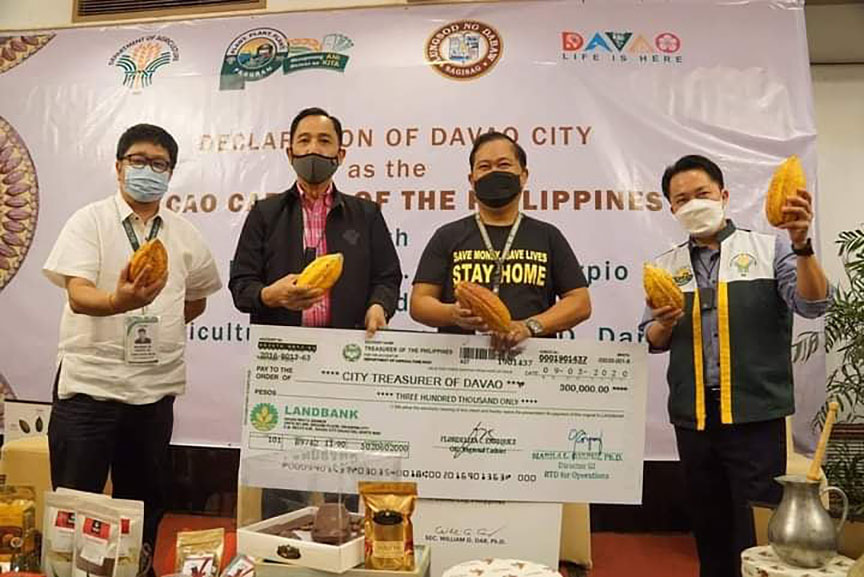DAVAO CITY (MindaNews / 8 Sep) – The City of Davao, the biggest cacao producer and the home of award-winning artisan dark chocolate brands in the country, has been officially declared as the “Cacao Capital of the Philippines.”
 Agriculture Secretary William Dar (2nd from left) leads the declaration of Davao City as the “Cacao Capital of the Philippines” with (L-R) Department of Agriculture-Davao director Ricardo Oñate, City Agriculturist Office head Leo Brian, and Agriculture Undersecretary Roldan Gorgonio. Photo courtesy of DA-Davao
Agriculture Secretary William Dar (2nd from left) leads the declaration of Davao City as the “Cacao Capital of the Philippines” with (L-R) Department of Agriculture-Davao director Ricardo Oñate, City Agriculturist Office head Leo Brian, and Agriculture Undersecretary Roldan Gorgonio. Photo courtesy of DA-Davao
Agriculture Secretary William Dar was here Monday to hand over the recognition to the local government of Davao.
Mayor Sara Duterte said during her live interview over Davao City Disaster Radio (DCDR 87.5) that the city attributed much of its success in cacao production to the farmers within the city – who produced 2,289 metric tons (MT) or 34.15 percent of the total 6,703 MT of dried cacao beans produced by the Davao Region last year based on data from Philippine Statistics Authority (PSA) – and other cacao industry players.
Davao del Norte came second highest with 1,372 MT, followed by Davao del Sur with 1,163 MT, Davao de Oro with 572.57 MT, and Davao Oriental with 561.57 MT, according to PSA.
The region’s combined cacao production comprised 78.96 percent of the country’s total production of 8,488.60 MT last year.
Aside from being crowned cacao capital, Duterte added that the city was also recognized as the regional winner of the Organic Program of the Department of Agriculture. “We are thrilled to be recognized in this year’s regional organic agriculture contest. I’d like to thank industry players and the agricultural industry,” Duterte said.
Duterte said the recognition is an “affirmation and celebration of the efforts of the cacao farmers and processors, and everyone in the cacao industry.”
“For the past few years now, Davao cacao has been recognized as among the world’s best, with our local brands making waves in international chocolate competitions, and a growing number of Filipino and foreign chocolate makers sourcing their beans here,” she said.
The city has produced a number of artisan chocolate makers, many of whom like Malagos Chocolates, MS3 Agri-Ventures, Auro Chocolates, won international awards.
According to the Department of Environment and Natural Resources in the region, cacao is part of the agency’s agroforestry component under the National Greening Program (NGP).
Of Davao Region’s 106,629 hectares of total national NGP planted sites, 16,739 hectares or 16 percent have been declared as cacao agroforest, “being maintained and nourished by the NGP’s people’s organizations” with technical assistance from the agency.
It added that apart from hitting the reforestation target in the region, cacao has been considered as one of the primary commodities due to its affirmative environmental impact as well as its soil suitability and economic advantages. (Antonio L. Colina IV / MindaNews)
